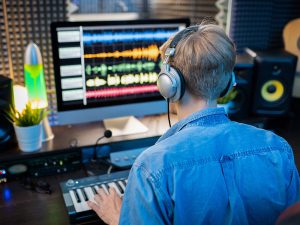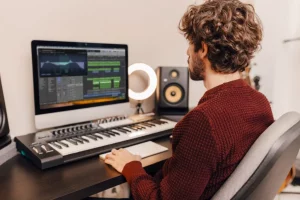Introduction
In the ever-evolving landscape of the music industry, technology has played a pivotal role in shaping how music is produced and distributed. From the early days of analog recording to the current era of digital innovation, music technology has continuously transformed the way artists create, record, and share their work with the world. This article delves into the multifaceted impact of technology on music production and distribution, highlighting key advancements and their implications for musicians, producers, and listeners alike.
The Evolution of Music Production Technology

-
Analog to Digital: A Paradigm Shift
The transition from analog to digital recording marked a significant milestone in music production. Analog recording, which involves capturing sound waves onto physical media such as tape, was the standard for much of the 20th century. However, the advent of digital recording technologies in the late 20th century revolutionized the industry. Digital recording allows for precise editing, manipulation, and storage of audio data, offering unprecedented flexibility and quality.
-
Digital Audio Workstations (DAWs)
One of the most transformative advancements in music technology is the development of Digital Audio Workstations (DAWs). DAWs are software platforms that enable musicians and producers to record, edit, mix, and master music using a computer. Popular DAWs like Ableton Live, Pro Tools, and Logic Pro have become essential tools in modern music production. They provide a range of features, including virtual instruments, effects, and automation, making it easier for artists to realize their creative visions.
-
Virtual Instruments and Plugins
The rise of virtual instruments and plugins has further expanded the possibilities of music production. Virtual instruments replicate the sounds of traditional instruments, such as pianos, guitars, and drums, using software. Plugins, on the other hand, are software add-ons that enhance the functionality of DAWs. They include effects like reverb, delay, and compression, as well as virtual synthesizers and samplers. These tools allow musicians to experiment with a wide array of sounds and textures without the need for physical instruments.
The Impact of Technology on Music Distribution

-
The Digital Music Revolution
The digital revolution has fundamentally changed the way music is distributed and consumed. The rise of the internet and digital file formats, such as MP3 and AAC, has made it possible to share music globally with ease. Online platforms like iTunes, Amazon Music, and Band camp have provided new avenues for artists to distribute their music directly to fans, bypassing traditional gatekeepers like record labels and distributors.
-
Streaming Services
Streaming services have become the dominant mode of music consumption in the 21st century. Platforms like Spotify, Apple Music, and Tidal offer vast libraries of music that users can access on-demand. These services use algorithms to recommend music based on listener preferences, creating personalized experiences. While streaming has democratized access to music, it has also raised concerns about fair compensation for artists, as revenue from streaming is often lower than from physical sales or downloads.
-
Social Media and Music Promotion
Social media platforms like Instagram, TikTok, and YouTube have become powerful tools for music promotion and discovery. Artists can share their music, engage with fans, and build a following without the need for traditional marketing channels. Viral trends and challenges on platforms like TikTok have propelled songs to global popularity, demonstrating the influence of social media on music distribution.
Challenges and Opportunities in the Technological Landscape

-
The Democratization of Music Production and Distribution
One of the most significant opportunities presented by technological advancements is the democratization of music production and distribution. Aspiring musicians no longer need access to expensive studio time or a major label deal to produce and release their music. With a laptop and affordable software, anyone can create and share their work with the world. This has led to a more diverse and inclusive music industry, with voices from all corners of the globe able to find an audience.
However, this democratization also presents challenges. The ease of entry into the music industry has led to an over saturated market, where millions of songs are released each year. For artists, standing out in this crowded field can be difficult, and breaking through to a larger audience requires not only talent but also savvy marketing and promotional strategies. Additionally, the shift towards streaming has made it harder for artists to earn a living solely from their music, as streaming royalties are often insufficient to support a sustainable career.
-
The Role of Data and Analytics
The rise of technology in music has also brought data and analytics to the forefront of the industry. Streaming platforms and social media sites collect vast amounts of data on listener behavior, preferences, and trends. This data can be invaluable for artists and labels, helping them understand their audience, optimize their release strategies, and even guide their creative decisions.
However, the reliance on data also raises concerns about the commercialization of music and the potential for creativity to be driven by algorithms rather than artistic vision. As the industry becomes more data-driven, there is a risk that music could become more formulaic, with artists tailoring their work to fit the preferences of algorithms rather than taking creative risks. Balancing the benefits of data with the need to preserve artistic integrity will be a key challenge for the music industry moving forward.
The Future of Music Technology

Image by: Google.com
-
Artificial Intelligence and Machine Learning
Artificial Intelligence (AI) and Machine Learning (ML) are poised to play an increasingly significant role in music production and distribution. AI-powered tools can assist with tasks such as songwriting, mixing, and mastering, offering new creative possibilities. For example, AI algorithms can analyze vast amounts of data to generate music that mimics the style of specific artists or genres. Additionally, AI-driven recommendation systems can enhance the personalization of music streaming services.
-
Virtual Reality and Augmented Reality
Virtual Reality (VR) and Augmented Reality (AR) technologies are opening up new frontiers for music experiences. VR concerts and immersive music videos allow fans to engage with music in novel ways, creating a sense of presence and interactivity. AR applications can overlay digital information onto the physical world, enhancing live performances with visual effects and real-time data.
-
Blockchain and Music Rights
Blockchain technology has the potential to address longstanding issues related to music rights and royalties. By creating transparent and immutable records of music ownership and usage, blockchain can ensure that artists receive fair compensation for their work. Smart contracts, which are self-executing agreements coded on the blockchain, can automate royalty payments and streamline licensing processes.
Conclusion
The role of technology in music production and distribution is both profound and dynamic. As advancements continue to unfold, the music industry will undoubtedly experience further transformation. For musicians, producers, and listeners, staying informed about the latest developments in music technology is essential to navigating this ever-changing landscape. Ultimately, technology will continue to shape the future of music, offering new opportunities for creativity, collaboration, and connection.










